What's in a name? Asian carp get a new, more palatable name: Copi
Slimehead is a staple at many grocery store fish counters, a mild white fish with a delicate flavor and flaky texture. Patagonia toothfish is reserved for menus at gourmet restaurants, with its subtly sweet flavor and rich butteriness.
If neither of these names sound familiar, however, that’s because both fish received marketing-friendly makeovers a few decades ago. On price lists and menu cards they are better known, respectively, as orange roughy and Chilean sea bass.
If rebranding made the slimehead and toothfish sound more palatable, experts are hoping it will also work with Asian carp. The invasive species shares little with its much maligned cousin, the common carp, when it comes to feeding habits and taste. But the similar name is enough to muddy the waters for the public, leaving Asian carp with an identity crisis.
So it’s getting a revamp, too: Good-bye Asian carp, hello Copi.
And really, don't copi tacos sound so much more appetizing than Asian carp tacos?
“Copi is a brilliant name. For me, it conjures up classy, possibly Mediterranean images associated with fine food,” said John Goss, the former director of the Indiana Department of Natural Resources and a consultant for the national Asian Carp Control Project.
Scrub Hub: What are jumping worms? And are they ruining my garden? (They just may be)
“It is clearly the opposite of the other four letter name for the delectable fish.”
What are copi?
The carp are an invasive species wreaking havoc on waterways across the Mississippi River Basin, including here in Indiana. They are eating all the food, crowding out native species and now make up the majority of fish in the rivers they’ve infested.
But the harmful fish are not currently in the Great Lakes — and cities, states and countries want to keep it that way.
Experts are counting on the rebranding to make Asian carp more palatable — literally — to consumers and set off a ripple effect. The new name is part of a broader plan to create demand and a market for copi that will help increase fishing and reduce the population while, hopefully, helping protect the Great Lakes. It also will have the potential side bonus of fostering a new industry around fishing and processing, all while introducing Midwesterners to a delicious new homegrown and healthy dining option.
Still, there are obstacles in the way.
The industry needs to actually establish all that infrastructure to meet the prospective demand. And while some states are better set up, Indiana is a bit behind. The state’s rules restrict certain types of equipment that would make commercial fishing for copi nearly impossible.
Scrub Hub: How do we get rid of these fleas?
The state is starting conversations on how to turn that around, but it’s early in the process.
“We need to show there is a viable fishery,” said Craig Jansen, who works in DNR’s Fish and Wildlife division. “It’s going to take a little bit of time, but I think it’s going to start coming together in the next couple years in full force.”
Carp are here to stay
Various species of Asian carp were brought to the southern U.S. in the 1970s as a way to help clean algae and control algal blooms in aquaculture ponds and wastewater treatment plants. And it worked well at first: carp are filter feeders that open and close their mouths constantly as they swim, similar to a whale. They can suck in as much as 20% of their weight in algae and zooplankton in a day.
Within 10 years, however, flooding along the Mississippi River allowed the fish to escape into the waterway. It didn’t take long before the carp population exploded up the river and many of its tributaries.
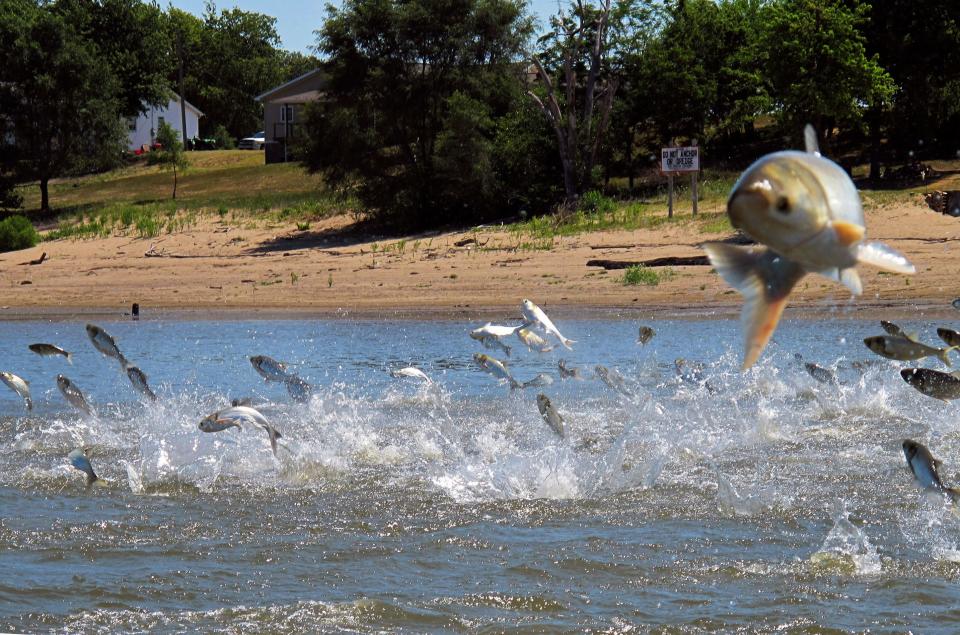
“It’s important to recognize that invasive carp are extremely hardy fish, and they can exist all the way from New Orleans all the way up to North Dakota,” said James Schardt, a life scientist in the Great Lakes National Program Office with the U.S. Environmental Protection Agency.
Many places around the Midwest region now have species of Asian carp, including major rivers in and around Indiana: the White, Wabash and Ohio rivers.
Once they arrive, Schardt said, “we have seen them taking over the rivers.”
The carp are voracious eaters. In those areas where they’ve established themselves, they make up anywhere from 70% to 90% of the fish biomass. That means native species are now only a fraction of what’s there.
There are four different species of Asian carp: Silver, bighead, black and grass. While their appearances differ slightly depending on the species, they generally are a heavy-bodied fish recognizable by their upturned jaw — like an underbite — and the eyes on the lower half of their heads.
They can grow to be bigger than 100 pounds and more than 3 feet long, but average closer to 30 pounds and between 1 to 2 feet. Silver carp in particular are known for their jumping, shooting out of the water when a boat buzzes by.
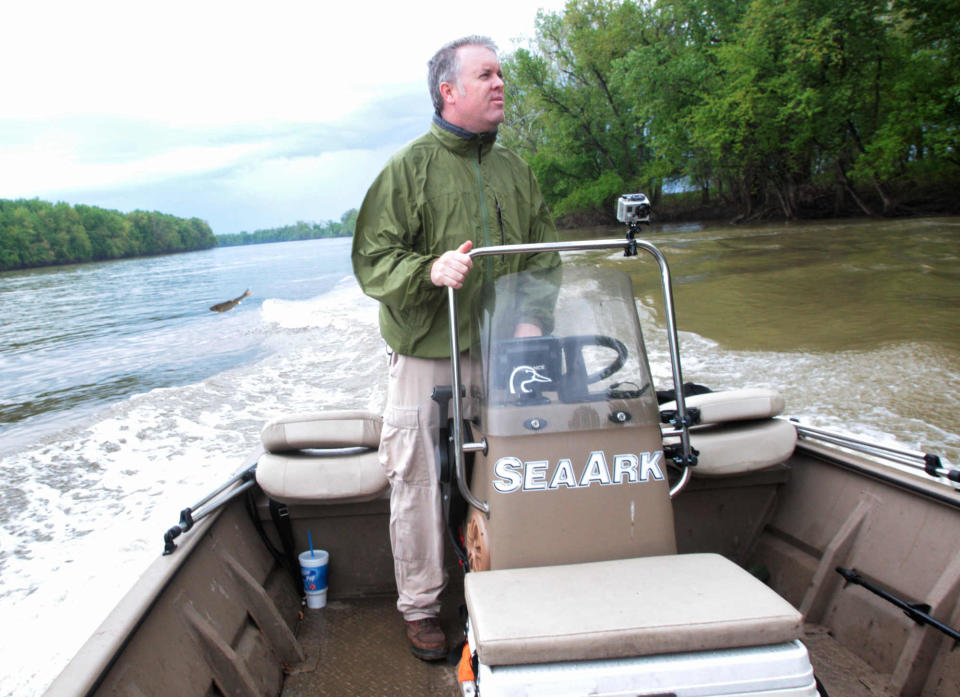
There is another type of carp in Indiana known as the common carp. While still not native to the state, it was introduced into the country more than a century ago and can be found all across Indiana. Like catfish, they have two small “whiskers” on each side of their mouth.
There is one main distinction between the different types of carp: How they feed. Carp are generally believed to be bottom feeders, but that is true only for common carp. The species of Asian carp, on the other hand, are top feeders that skim for food near the water’s surface.
Can't compete with carp
Though common carp are considered invasive, they are not causing the same issues that Asian carp are inflicting on the waterways. The root of the problem is that Asian carp out-compete native species for resources.
“At first everyone thought ‘oh well, they’ll probably just be another fish out there,’” said Goss, the former DNR director. “But then the population got so condensed so quickly.”
Algae and zooplankton are a critical food source for young native fish, which now are being robbed of their meals. Asian carp also reproduce significantly faster than any native fish, with each adult female laying up to one million eggs every year. Even if only 5% survive, “the population still rises very quickly,” Goss said.
All those fish take up limited space.
Though Asian carp don’t physically harm the other fish, in the end, native species don’t stand a chance.
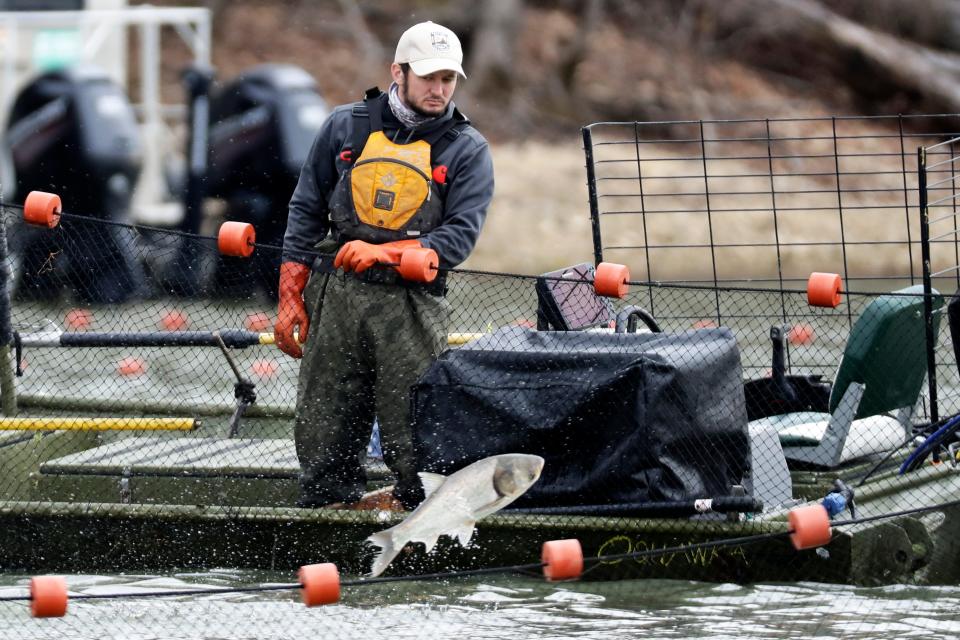
As the carp have made their way north, fishers, environmental groups and state agencies have seen the harm left in their wake. They are now knocking on the door of the Great Lakes, but haven’t made it inside — yet.
“We don’t want to run that experiment in the Great Lakes,” said Schardt, the EPA scientist. “We want to keep them in the areas they are already in and reduce their populations in those places.”
Officials are seriously concerned about the impact Asian carp could have if they were to break through. It could devastate the wildlife, as well as the multi billion-dollar tourism and fishing industries built up around the lake ecosystem. The impact of fisheries in the Great Lakes alone is estimated at $7 billion, Schardt said.
“The Great Lakes are the big prize we need to protect,” said Kevin Irons, an aquatic species expert with the Illinois Department of Natural Resources. “We’re going to use every tool and all tools to accomplish our goal.”
Efforts have been underway for nearly 15 years to keep them out and reduce their populations. Every year, an updated Invasive Carp Action Plan is published — it reflects the various funding available and the overall coordination between the EPA and state agencies to address carp.

It’s been described almost as a battle plan. Between state and federal partnerships, they’ve installed an electric barrier near Chicago, built up an earthen levee in northeast Indiana and created fishing incentives for Asian carp, among others.
“And there is progress there,” said Nick Adam, a design principal at Span, the company that worked with wildlife agencies to rebrand Asian carp. “But they were noticing these efforts will never completely solve the problem. We need to have another approach on top of these.”
Rebranding from carp to copi
That’s where this new effort to rename Asian carp comes in.
Many people associate all carp as being one and the same — but when it comes to eating them, they are very different. As bottom feeders, common carp don’t taste great. They have a darker meat and a stronger, earthier, some even say muddier, flavor.
Goss remembers fishing with his dad near Columbus, Ind. when he was younger.
“Somebody once said that the best way to cook and eat a common carp is to nail it to a pine board, smoke it, and then throw the fish away and eat the board,” Goss said.
He would not recommend the same treatment for Asian carp, or what is now referred to as copi. It’s a delicious white fish — a Chicago chef has described it as being more savory than tilapia, cleaner-tasting than catfish and firmer than cod.
Copi can be steamed, broiled, pan fried, baked, grilled or roasted. Goss said that in a blind taste test with catfish and other white fish, many people actually preferred the copi.
But as Asian carp, many people wouldn’t choose to eat it. According to a survey as part of the renaming effort, 85% of respondents have heard of Asian carp, but only 5% have ever eaten it. It has a name-based perception issue, Adam said, and “no distributors ever thought of risking their business to sell it.”
Officials are hoping more people will choose to eat copi. Irons said he is already hearing from restaurants and distributors that they think the name — officially launched in June — is going to stick.
The new name comes from the word “copious.” There are copious amounts of the fish in the region’s waterways and there are copious ways to cook and eat it.
The U.S. actually is the outlier when it comes to not eating copi. It’s a major food source in many other countries, particularly in Asia, where they call the fish by the particular species name, such as bighead or silver carp. It’s also a major farm-raised fish across the globe.
“They are one of the most aquacultured fish in the world for food,” said Irons, the aquaculture and aquatic nuisance species program manager for Illinois DNR. “So their properties are there, but something wasn’t working here in the Midwest.”
Creating the copi market
With a new name, officials hope copi can shake off carp’s old reputation and become more approachable and desirable. In turn, that will create demand for the fish among consumers at stores and restaurants. That trickles down to distributors, processors, fishers and ultimately establishes a market for copi.
When there’s demand, an industry will sprout up to meet it. Commercial fishing for copi will grow to supply what’s needed — Irons hopes to get to a point where they are pulling as many as 15 million to 20 million pounds of copi every year out of just the Illinois River.

Imagine what’s possible across the region, he said.
“We can’t get enough of this fish out,” said Irons, whose agency has been leading the renaming charge. “But without the branding and marketing and encouragement of that, fishermen aren’t making enough money to motivate more fishing of copi.”
Adam agrees. Until today, the vast majority of a fisherman's catch was “this extremely delicious fish that there wasn’t a market for.” But now there is a place to bring them: Seven distributors have already signed on as part of the new Choose Copi campaign and several restaurants in Chicago now have copi on their menus.
The benefits of eating copi are quite copious, as well — both to people and the environment.
Fishing along midwestern rivers has been a dying industry as native species have dwindled, but new demand for copi could bring those jobs back and even create new ones with processing and distribution.
Copi also provides a healthy and affordable food option. Its protein is second only to salmon, according to research, and it also is high in fatty acids and low in harmful metals thanks to being a top filter feeder.
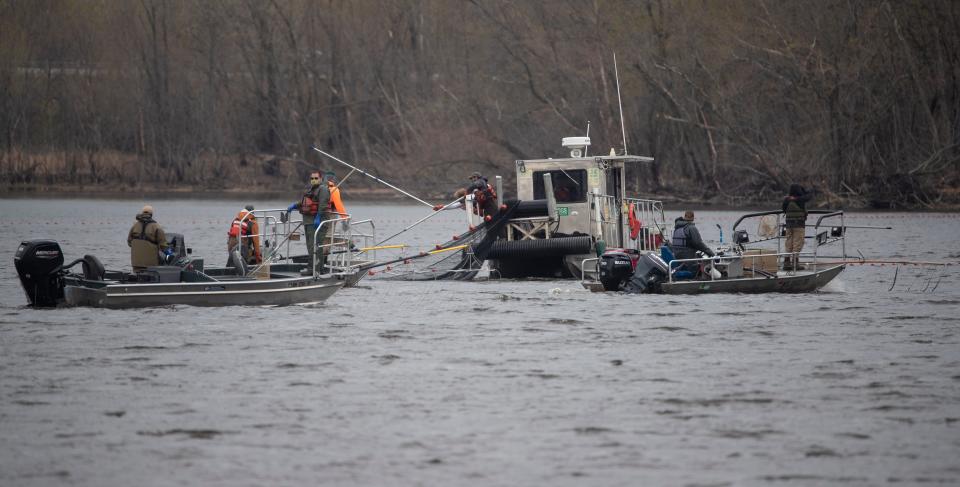
Potentially most importantly, creating a market for copi provides a means to get these invasive and harmful fish out of waterways and the opportunity for native species to rebound.
“Right now, fishing and harvesting is one of the best tools we would have to basically lower the numbers of any fish population out there,” said Jansen of the Indiana DNR.
“There’s still a lot of work ahead, but we hope we will start to see some impact in the next couple years.”
Challenge in catching carp
Though experts think the potential is big, there are still some obstacles in the way. The main one being that fishing for Asian carp in Indiana is not really possible, at least not at a commercial scale.
Current fishing rules in the state prevent the use of gill nets, which are nets that are hung vertically in the water like a curtain or wall. They were banned in Indiana a few decades ago after issues with commercial fishing of other native species in Indiana waters.
The problem, however, is that gill nets are the most effective way to fish for carp. As they are filter feeders, hook and line won’t work.
Other states are moving ahead with large-scale fishing, including in Illinois on the Illinois River and Kentucky on the Ohio River. Kentucky established a contract fishing program roughly three years ago, that allows crews to go out a few days every week to run nets. Indiana has even been partnering with Kentucky to allow those fishers to enter Indiana’s waters on the Ohio River for fishing, Jansen said.

Indiana officials are now starting to look at how to open up the state for carp fishing. That could mean changing the rules, Jansen said, or creating a special fishing permit that allows for the use of gill nets in certain areas for commercial fishing. They also are looking to mirror Kentucky’s contract fishing program.
“When it comes to carp, we don’t want to restrict any harvest, we want to allow as much as possible,” he said. “But we want to make sure we are doing it the right way on the regulatory side of things and it also won’t impact our native fish species. Those are the challenges right now.”
It will take some time, Jansen added, but that is the future.
In the meantime, Illinois and Indiana are partnering on an incentive program that is federally funded. Fishers can receive an additional 10 cents per pound of carp taken out of the Wabash, and processors can get the same amount for establishing a collection point near the river for fishers to drop off their catch.
That program kicked off just a few months ago, but it’s a start, Jansen said.
Is copi the future?
Once the fish are caught, work still needs to be done to set up the infrastructure to move the fish from the rivers to the distributors and then out into stores and restaurants. While processors already exist for other types of fish, copi has a lot of small bones that mean it needs to be broken down and handled differently.
“Right now we don’t have processors in the state that can handle these products. The biggest reason is we don’t have a way to show them that there is enough here to open a plant,” Jansen said. “But if we can show them there are enough fish here, hopefully they will set up shop here in Indiana.”
That kind of space and equipment and manpower will take capital. So what happens to that investment years down the road? State and federal agencies will have to work with the industry to find a balance between creating the market but also achieving the goal of reducing carp populations in the water. Carp numbers aren’t going to drop overnight, it is going to take years. Still, officials are not trying to create a sustainable fishery for the carp.
“We want processors to succeed right now and take out as many fish as possible,” Jansen said, “but in future, we are not actively managing to sustain the population.”
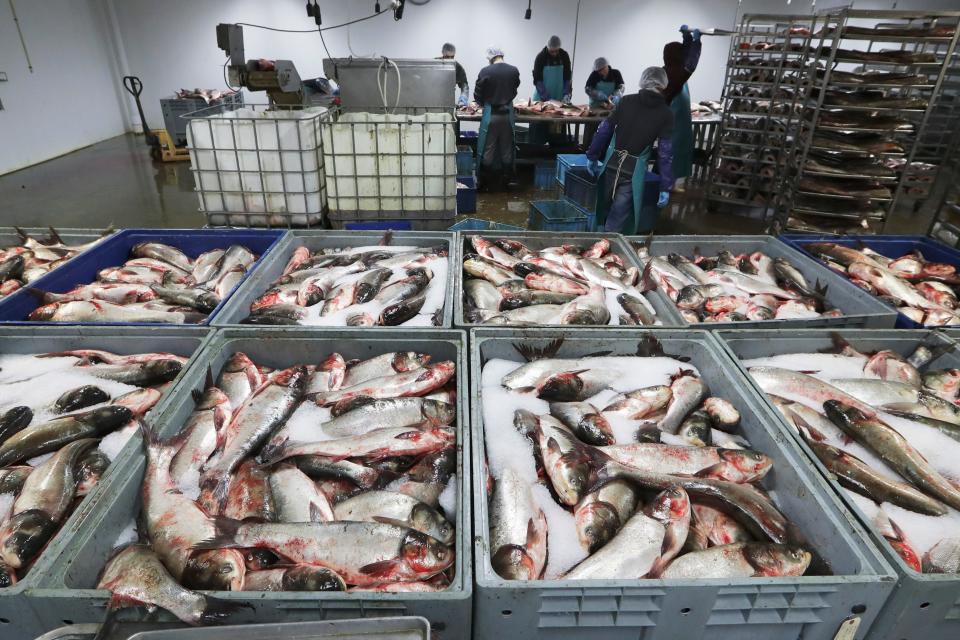
They want to bring number down as low as it can go — even if that means there aren’t enough carp for fishing in the future. Both Jansen and Irons think Asian carp will always be around, that’s just the nature of this hardy fish and how they reproduce.
“There is going to be a sweet spot where market pressures start to keep this fish population suppressed,” said Irons of the Illinois DNR. “It’s going from 70% or 80% of biomass in our waters to 10% or 20%, and getting to a balance where our native species are protected.”
Everything right now is baby steps, he said, and there is a long way to go before millions of pounds of carp are being removed. While the rebranding to copi may seem like the finish line, Irons said it feels like they are just getting to the starting gate.
“The compass is set and people are working together,” Irons said. “The name is that important flashpoint to gather around.”
Call IndyStar reporter Sarah Bowman at 317-444-6129 or email at sarah.bowman@indystar.com. Follow her on Twitter and Facebook: @IndyStarSarah. Connect with IndyStar’s environmental reporters: Join The Scrub on Facebook.
IndyStar's environmental reporting project is made possible through the generous support of the nonprofit Nina Mason Pulliam Charitable Trust.
This article originally appeared on Indianapolis Star: Going from 'eww' to 'yum' — Asian carp get a fresh new name: Copi

